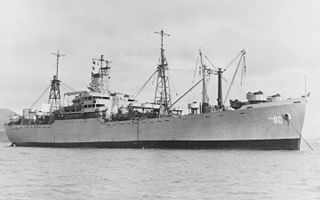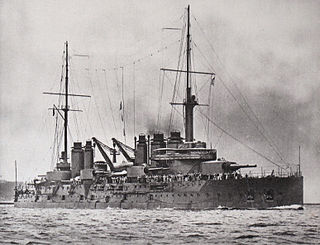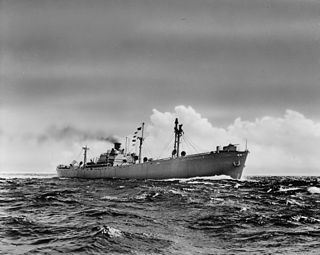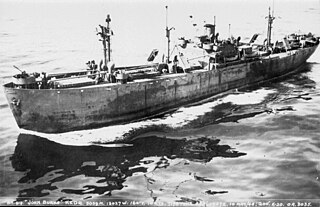
Type C2 ships were designed by the United States Maritime Commission (MARCOM) in 1937–38. They were all-purpose cargo ships with five holds, and U.S. shipyards built 328 of them from 1939 to 1945. Compared to ships built before 1939, the C2s were remarkable for their speed and fuel economy. Their design speed was 15.5 knots (28.7 km/h), but some could make 19 knots (35 km/h) on occasion. The first C2s were 459 feet (140 m) long, 63 feet (19 m) broad, and 40 feet (12 m) deep, with a 25-foot (8 m) draft. Later ships varied somewhat in size. Some, intended for specific trade routes, were built with significant modifications in length and capacity.

SS Alexander Macomb was a Liberty ship built in the United States during World War II. She was named after Alexander Macomb, the Commanding General of the United States Army from May 29, 1828, until his death on June 25, 1841. Macomb was the field commander at the Battle of Plattsburgh, during the War of 1812, and after the stunning victory, was lauded with praise and styled "The Hero of Plattsburgh" by some of the American press. He was promoted to Major General for his conduct, receiving both the Thanks of Congress and a Congressional Gold Medal.

Danton was a semi-dreadnought battleship of the French Navy and the lead ship of her class. She was a technological leap in battleship development for the French Navy, as she was the first ship in the fleet with turbine engines. However, like all battleships of her type, she was completed after the Royal Navy battleship HMS Dreadnought, and as such she was outclassed before she was even commissioned.
SS Breda was a Dutch cargo-passenger ship sunk in Scotland during World War II.
SS Eastfield was a 2,150-ton armed steamship which was torpedoed by the German U-boat SM UB-57 on 27 November 1917. The wreck sits intact at 50°14.255′N4°42.262′W at a depth of 50 metres (160 ft) off Mevagissey, Cornwall. The cargo of coal can be found scattered on the sea bed nearby.
SS Stanwood was a British collier that was sunk off Falmouth in December 1939 after her cargo of coal caught fire.

SS Thomas Heyward was a Liberty ship, Maritime Commission hull number 236, built by Alabama Drydock and Shipbuilding Company at Mobile, Alabama, laid down 21 February 1942, and launched 31 May 1942. It was named for Thomas Heyward, Jr., a signer of the United States Declaration of Independence and of the Articles of Confederation as a representative of South Carolina.

The SS Gairsoppa was a British steam merchant ship built in Jarrow and launched in 1919. After a long civilian career, she saw service during the Second World War. She was named after the town of Gerusoppa on the banks of River Sharavati in Karnataka, India, which due to its easy access to water transportation and as a distribution centre for crops including pepper, was the commercial capital for centuries.

Western Maid was a 5,760 GRT cargo ship that was built in 1918 by the Northwest Steel Company, Portland, Oregon, USA. She was built for the United States Shipping Board (USSB), but was commissioned into the United States Navy on completion as USS Western Maid, with the pennant number ID-3703. In 1919 she was decommissioned and returned to the USSB. In 1937 she was passed to the United States Maritime Commission. In 1940 she was transferred to the British Ministry of Shipping and renamed Empire Cormorant, passing to the Ministry of War Transport (MoWT) in 1941. In 1945 she was scuttled in the North Atlantic with a cargo of obsolete war matériel.

Scantic was a 326 GRT coaster that was built in 1936 by Noord Nederland Scheepsmakkerij, Groningen as Dr Colijn for a Dutch owner. In 1940, she was transferred to the Ministry of War Transport (MoWT) and renamed Empire Crocus. In 1947, she was sold into merchant service and renamed Stainton. A further sale in 1951 saw her renamed Benwood. In 1955 she was sold to Finland and renamed Monica. A further sale to Sweden in 1957 saw her renamed Mona. In 1963, she was sold to Denmark and renamed Scantic, serving until 7 December 1964 when she foundered in St Georges Channel, United Kingdom.

SS John Burke was an American Liberty Ship built during World War II, one of the 2,710 type 'EC2-S-C1' ships that carried all kinds and types of dry cargo during the war. The ship was named for John Burke, the 10th Governor of North Dakota. Burke was built at Kaiser Shipbuilding Company's Oregon Shipbuilding yard in Portland, Oregon. Burke's keel was laid November 20, 1942 and the hull was launched on December 13. After fitting-out, Burke was delivered to the US Maritime Commission on December 23, just 33 days after construction began. The War Shipping Administration then placed Burke under management of the Northland Transportation Company.
SS Maasdam was a Dutch steam merchant and was the third of five with this name in the Holland America Line. She was originally launched 21 October 1920, with a length of 466, beam of 58 feet and displacement of 8,812. Constructed at Rotterdam, she was originally designed as a combination cargo and passenger vessel. She had a crew of eighty-nine and originally showed two funnels, but only one was functioning. The ship laid up in 1933 and overhauled the next year with the dummy funnel and some passenger cabins removed, and crew size to forty-eight.

SS Fuso Maru was a Japanese ocean liner that was torpedoed by the United States Navy submarine USS Steelhead (SS-280) in the South China Sea 280 nautical miles (520 km) northwest of Cape Mayraira, Luzon, the Philippines, at, while she was travelling in Convoy MI-11 from Moji, Japan, to Miri, Borneo.
SS Ajax was a cargo steamship that was built in Germany in 1923 as Elbe. In 1927 she was renamed twice, first to Ceuta and then to Ajax.

SS Benjamin Contee was an American Liberty Ship type EC2-S-C1 built in 1942 by the Delta Shipbuilding in New Orleans, Louisiana as part of the Emergency Shipbuilding Program for World War II. She was laid down on February 2, 1942, launched on June 15, 1942 and completed on August 7, 1942. She was operated by the Mississippi Shipping Company for the War Shipping Administration as a United States Merchant Marine ship. She was a Maritime Commission design. Like other Liberty ships, she was 441 feet (134 m) long and 56 feet (17 m) wide, carried 9000 tons of cargo and had a top speed of 11 knots (20 km/h). Most Liberty ships were named after prominent deceased Americans. She was converted from a cargo ship to a troop transport ship. She is named after Benjamin Contee, an American Episcopal priest and statesman from Maryland. He was an officer in the American Revolutionary War, a delegate to the Confederation Congress, and a member of the first United States House of Representatives.
SS El Kahira was a British Passenger/Cargo ship that sank during a storm in the English Channel on 9 July 1922 while she was travelling from London, United Kingdom to Algiers, Algeria while carrying a cargo of 1,310 tons of bagged sugar.

SS India Victory was a Victory ship built and operated as a cargo carrier and troopship in World War II. After the war was used a private cargo ship. She sank on 12 July 1972, ran aground on a Pratas Reef in the South China in Typhoon Susan.








